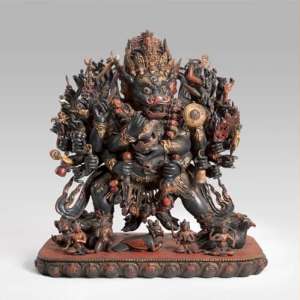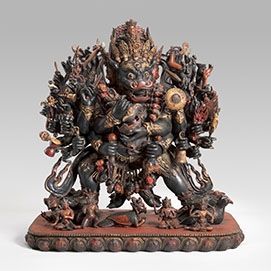
Read the transcript of this episode.
Life can be chaotic. Do we really have to face it in order to taste enlightenment? In our first episode, we speak with comedian Aparna Nancherla about her own relationship to inner turmoil, from pushing discomfort away to the relief of acknowledging it. She shares what it was like growing up a child of immigrants, her journey to recovery from an eating disorder, and how her struggle with anxiety and depression found its way into her standup routine.
To begin, Aparna engages with a contemporary painting by Tsherin Sherpa, titled Luxation 1. Luxation means dislocation or displacement, and across sixteen panels that depict fragments of a Buddhist deity, the painting references the cultural dislocation felt by the artist.
ABOUT THE GUEST
Aparna Nancherla started out doing comedy in her hometown of Washington, DC, and now resides in New York City. Elle’s 2016 Women in Comedy Issue featured her as one of the most exciting new voices to hit the comedy scene. She is a series regular in Corporate and has roles in Crashing and The Standups. Her other television credits include Mythic Quest: Raven’s Banquet, Master of None, Love, High Maintenance, Inside Amy Schumer, Unspun with Matt Forde, and I Love You, America with Sarah Silverman. She is the voice of Meena on Mira, Royal Detective, Hollyhock on BoJack Horseman, and Moon on The Great North. Her TV writing credits include Late Night with Seth Meyers, and she is a regular correspondent and writer on Totally Biased with W. Kamau Bell.
ABOUT THE ART FROM THIS EPISODE

The fragmented image of the Buddhist deity Vajrabhairava, who is known as conqueror of death, appears chaotic with missing information between the canvases. It may indicate the confusion felt in an unenlightened mind, where only some things can be recognized but the whole picture and its true significance are unclear. This multipanel painting is the artist’s response to the devastating earthquake that shook Nepal in 2015. Its title means dislocation or displacement, and it references the cultural dislocation of both the artist and Tibetan Buddhism.
PRODUCTION CREDITS
AWAKEN is produced by the Rubin Museum of Art with Vincent Baker, Dawn Eshelman, Jamie Lawyer, Sandrine Milet, Elena Pakhoutouva, and Dawnette Samuels. It was produced in collaboration with Sound Made Public, with Tania Ketenjian, Katie McCutcheon, and Philip Wood.
Special thanks to Karen Sorensen for additional consulting.
All music for AWAKEN was created by Blue Dot Sessions, Podington Bear, Tendinite, and Siddhartha Corthus.
OUR GENEROUS SUPPORTERS
This podcast is supported by Barbara Bowman, the Ellen Bayard Weedon Foundation, The Prospect Hill Foundation, Bob and Lois Baylis, public funds from the New York City Department of Cultural Affairs in partnership with the City Council, and by the New York State Council on the Arts with the support of Governor Andrew M. Cuomo and the New York State Legislature, as well as by generous donations from the Museum’s Board of Trustees, individual donors, and members.
AWAKEN is sponsored by Tricycle: The Buddhist Review, a print and digital magazine dedicated to making Buddhist teachings broadly available.


Photo Credit:
Robyn Von Swan


